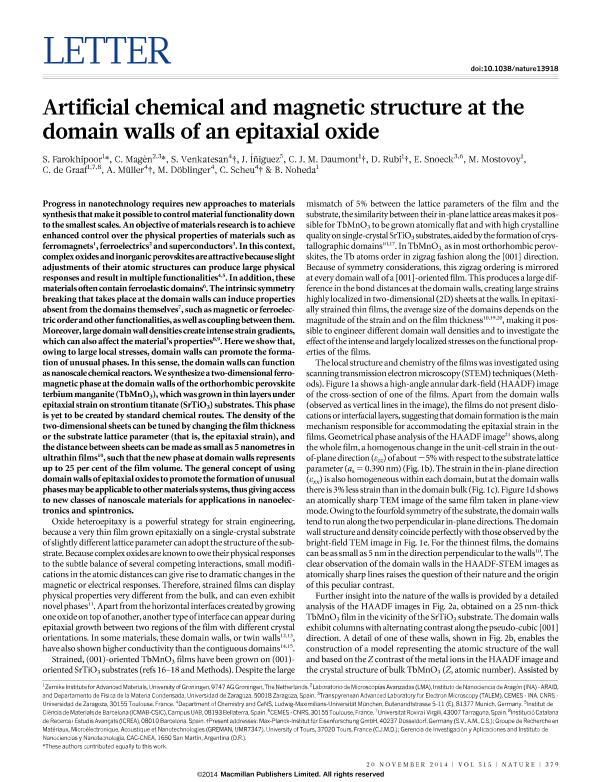Mostrar el registro sencillo del ítem
dc.contributor.author
Farokhipoor, S.
dc.contributor.author
Magén, C.
dc.contributor.author
Venkatesan, S.
dc.contributor.author
Íñiguez, J.
dc.contributor.author
Daumont, C.J.M.
dc.contributor.author
Rubi, Diego

dc.contributor.author
Snoeck, E.
dc.contributor.author
Mostovoy, M.
dc.contributor.author
De Graaf, C.
dc.contributor.author
Müller, A.
dc.contributor.author
Döblinger, M.
dc.contributor.author
Scheu, C.
dc.contributor.author
Noheda, B.
dc.date.available
2018-02-16T13:07:53Z
dc.date.issued
2014-11
dc.identifier.citation
Farokhipoor, S.; Magén, C.; Venkatesan, S.; Íñiguez, J.; Daumont, C.J.M.; et al.; Artificial chemical and magnetic structure at the domain walls of an epitaxial oxide; Nature Publishing Group; Nature; 515; 11-2014; 379-383
dc.identifier.issn
0028-0836
dc.identifier.uri
http://hdl.handle.net/11336/36587
dc.description.abstract
Progress in nanotechnology requires new approaches to materials synthesis that make it possible to control material functionality down to the smallest scales. An objective of materials research is to achieve enhanced control over the physical properties of materials such as ferromagnets1, ferroelectrics2 and superconductors3. In this context, complex oxides and inorganic perovskites are attractive because slight adjustments of their atomic structures can produce large physical responses and result in multiple functionalities4,5. In addition, these materials often contain ferroelastic domains6. The intrinsic symmetry breaking that takes place at the domain walls can induce properties absent from the domains themselves7, such as magnetic or ferroelectric order and other functionalities, as well as coupling between them. Moreover, large domain wall densities create intense strain gradients, which can also affect the material’s properties8,9. Here we show that, owing to large local stresses, domain walls can promote the formation of unusual phases. In this sense, the domain walls can function as nanoscale chemical reactors. We synthesize a two-dimensional ferromagnetic phase at the domain walls of the orthorhombic perovskite terbium manganite (TbMnO3), which was grown in thin layers under epitaxial strain on strontium titanate (SrTiO3) substrates. This phase is yet to be created by standard chemical routes. The density of the two-dimensional sheets can be tuned by changing the film thickness or the substrate lattice parameter (that is, the epitaxial strain), and the distance between sheets can be made as small as 5 nanometres in ultrathin films10, such that the new phase at domain walls represents up to 25 per cent of the film volume. The general concept of using domain walls of epitaxial oxides to promote the formation of unusual phases may be applicable to other materials systems, thus giving access to new classes of nanoscale materials for applications in nanoelectronics and spintronics.
dc.format
application/pdf
dc.language.iso
eng
dc.publisher
Nature Publishing Group

dc.rights
info:eu-repo/semantics/openAccess
dc.rights.uri
https://creativecommons.org/licenses/by-nc-sa/2.5/ar/
dc.subject
Thin Films
dc.subject
Manganites
dc.subject
Domain Walls
dc.subject
Ferromagnetism
dc.subject.classification
Astronomía

dc.subject.classification
Ciencias Físicas

dc.subject.classification
CIENCIAS NATURALES Y EXACTAS

dc.title
Artificial chemical and magnetic structure at the domain walls of an epitaxial oxide
dc.type
info:eu-repo/semantics/article
dc.type
info:ar-repo/semantics/artículo
dc.type
info:eu-repo/semantics/publishedVersion
dc.date.updated
2018-02-14T13:20:32Z
dc.journal.volume
515
dc.journal.pagination
379-383
dc.journal.pais
Reino Unido

dc.journal.ciudad
Londres
dc.description.fil
Fil: Farokhipoor, S.. University of Groningen; Países Bajos
dc.description.fil
Fil: Magén, C.. Universidad de Zaragoza; España
dc.description.fil
Fil: Venkatesan, S.. Technische Universitat Munchen; Alemania. Universite de Tours; Francia. Gerencia de Investigación y Aplicaciones; Argentina. Instituto de Nanociencias y Nanotecnología; Argentina
dc.description.fil
Fil: Íñiguez, J.. Consejo Superior de Investigaciones Científicas; España
dc.description.fil
Fil: Daumont, C.J.M.. University of Groningen; Países Bajos. Universite de Tours; Francia. Gerencia de Investigación y Aplicaciones; Argentina. Instituto de Nanociencias y Nanotecnología; Argentina
dc.description.fil
Fil: Rubi, Diego. University of Groningen; Países Bajos. Universite de Tours; Francia. Gerencia de Investigación y Aplicaciones; Argentina. Instituto de Nanociencias y Nanotecnología; Argentina
dc.description.fil
Fil: Snoeck, E.. Universidad de Zaragoza; España
dc.description.fil
Fil: Mostovoy, M.. University of Groningen; Países Bajos
dc.description.fil
Fil: De Graaf, C.. University of Groningen; Países Bajos. Universitat Rovira I Virgili; España. Institució Catalana de Recerca i Estudis Avançats. Barcelona; España
dc.description.fil
Fil: Müller, A.. Technische Universitat Munchen; Alemania. Universite de Tours; Francia. Gerencia de Investigación y Aplicaciones; Argentina. Instituto de Nanociencias y Nanotecnología; Argentina
dc.description.fil
Fil: Döblinger, M.. Technische Universitat Munchen; Alemania
dc.description.fil
Fil: Scheu, C.. Technische Universitat Munchen; Alemania. Universite de Tours; Francia. Gerencia de Investigación y Aplicaciones; Argentina. Instituto de Nanociencias y Nanotecnología; Argentina
dc.description.fil
Fil: Noheda, B.. University of Groningen; Países Bajos
dc.journal.title
Nature

dc.relation.alternativeid
info:eu-repo/semantics/altIdentifier/doi/http://dx.doi.org/10.1038/nature13918
dc.relation.alternativeid
info:eu-repo/semantics/altIdentifier/url/https://www.nature.com/articles/nature13918
Archivos asociados
